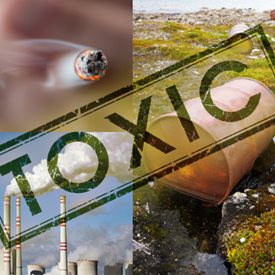From Atomic Bomb to Lead and Pollution, Environmental Researchers Celebrate Rich History and Promising Future
URMC scientists are honoring decades of investigating the impact of environmental exposures on health— dating back to the 1940s when they first looked into the toxicants used in the atomic bomb, to more modern concerns like lead, mercury, air pollution, pesticides, nanomaterials, and epigenetics.
“The breadth and depth of environmental health sciences research at URMC is truly astounding and worth lauding for its impact and longevity,” said Deborah A. Cory-Slechta, Ph.D., acting chair of the Department of Environmental Medicine, which houses the Environmental Health Sciences Center (EHSC).
In celebration of 50 years of science, the EHSC is conducting a first-ever research symposium and community discussion on Sept. 23 and 24.
The EHSC was officially established in 1975 when the National Institutes of Environmental Health Sciences initially awarded a core center grant. Since then the EHSC has been continuously funded for 40 years. But in the decade preceding that award, URMC environmental scientists had already risen to national prominence in studying the toxicology of metals, which led to the approval of a Ph.D. program in Toxicology, and for a 1970s groundbreaking investigation led by Tom Clarkson, Ph.D., into methylmercury poisoning in Iraq, the largest mercury poisoning in history.
Here are some of the key events at the symposium:
- At 7 p.m. Wed., Sept. 23, Matthew Rand, Ph.D., kicks off with a Science Café lecture at the Barnes and Noble in Pittsford (3349 Monroe Avenue, second-floor community room), titled “Mercury in Fish, Mercury in Us: How Do We Deal with It.”
- Beginning at 9 a.m., Thurs., Sept. 24, in the URMC Class of ’62 Auditorium and Flaum Atrium, department faculty will give a series of talks, capped by a community panel discussion to reflect on past and future EHSC engagement. The morning session focuses on the history of EHSC, particularly on mercury, air pollution and lead research.
- At 12:45 p.m., Cory-Slechta will deliver the opening afternoon lecture, “Autism and Air Pollution.” Additional speakers will present data on developmental exposures and epigenetics, which is the study of passing environmental exposures on through generations. Epigenetics is on the cutting edge of environmental health research, as scientists explore how lifestyle factors such as nutrition and other exposures influence genes.
- At 2:30 p.m., a community panel will discuss how EHSC has supported environmental health improvement in the Rochester area and explore future opportunities for collaboration. The panel includes Holly Anderson, executive director of the Breast Cancer Coalition of Rochester; Yolanda Sayres, outreach coordinator for Healthy Baby Network; Wade Norwood, chief program officer at Finger Lakes Health Systems Agency; and Ben Bruce, an assistant Attorney General in the Rochester office who also works in the environmental protection bureau.

